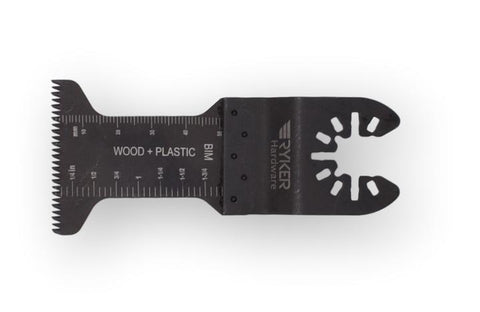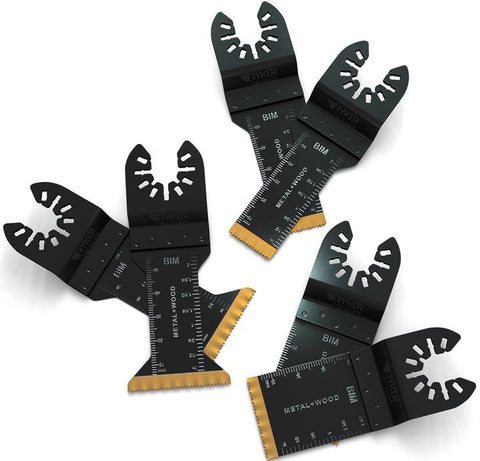How do you choose the right saw blade for your contractors’ toolbox?
You don’t want to purchase every type or brand of saw blade. They’re heavy, cumbersome, and (moderately) pricey. You want to invest in a few select saw blades that are versatile and most effective for your specific type of projects.
But with so many saw blades on the market, how do you know which ones are right for your business?
In this article, we’re focusing on the differences between Western and Japanese blades specifically. Check out some of our other resources to select other types of saws and tools:
- 5 Best Table Saw Blades For Woodworkers
- Jigsaw Blades: Which Jigsaw Blade Should You Buy
- Best Multi-Saw Blades For Stone Cutting
- How To Choose The Best Miter Saw Blade
What do you need to look for in a saw blade?
There’s a lot to consider when purchasing a saw blade. Below are the basics to look for when you’re selecting between blades or brands.
- Teeth: Higher tooth counts (50-80 tpi) will give smoother cuts, while lower tooth counts (24-30 tpi) create rougher cuts.
- Cut: Rip cuts are long cuts made with the wood of the grain, usually with a low-tooth count blade, while a crosscut works against the grain with a higher-tooth count blade.
- Thickness: Thicker blades make it harder it is to make a clean cut, but they also work at a faster rate. You want a thicker blade for rougher wood and a thinner blade for greater precision.
- Length: Longer saw blades create lengthier strokes (and are usually the preferred method), while shorter saw blades are good for small projects or shallow cuts.
- Handle: Consider the length, grip, and hold of the handle, which will help you wield and control the saw.
- Cost: Budget for the initial cost for purchase along with any necessary replacement blades.
There are other considerations as well, like tooth configuration, hook angle, kerf width, and quality.
Often, the type of saw you’ll need depends on the material and the project.
For example, plywood tends to tear a lot, making it more challenging to create a cleaner cut. This typically means you’ll want a high-tooth count blade for a smooth edge, and you’ll want to focus on rip cuts as opposed to the rougher crosscuts.
Pro-tip: Tooth count is the most important aspect to your saw blade. It has the highest impact on the cleanness of the cut. Generally, you should use less than 30 tpi (teeth per inch) for rip cuts, 40-50 tpi for combination, and 60 tpi for cross cuts.
Below we go through the most common Japanese blades in comparison with Western blades to give you a sense of which might work best for your project.
Japanese Dozuki Saw Blade
In general, Japanese saws (nokogiri) are less time-consuming and fatiguing than Western saws, because they are designed to cut on the pull, rather than on the push. Western blades usually cut on the push cut, which is actually a less natural movement. Once you get used to the pull of the Japanese saw, it’s often easier and less tiring. There are three main types of Japanese saw blades: dozuki, Kataba, and Ryoba.
Dozuki saw blades
The dozuki saw blade is a favorite for a number of woodworkers, and it’s the most commonly known Japanese blade.
Teeth: Dozuki blades come in a range of teeth size. Most are 22 to 27 tpi, which tends to create a rougher cut for pieces 1/8 to 1 inch thick. You can also find dozukis with large teeth (13 to 18 tpi) or small teeth (more than 32 tpi). Because of the thinness of the blade, smaller teeth can be harder to control with a dozuki blade. The teeth have small, angled tips that create a smooth and easy cut.
Cut: Crosscut dozukis cut with the grain and are better for general-purpose work. They’re less aggressive and easier to learn for beginners. Rip-cut dozukis make sawing across the grain easy, especially for dovetails. Due to its thin blade, it can only cut about 2” deep.
Thickness: Dozuki blades are very thin. These cut an extremely narrow kerf, removing nearly half as much wood as a standard blade. They have a blade stiffener (spine) that runs the length of the blade and the handle, but they’re typically not as sturdy as Western spines.
Length: Dozukis tend to come in two sizes: short (6 to 8 in) or long (9.5 to 10.5 in). Long blade dozuki saws tend to work best because they allow for a longer and smoother stroke.
Handle: Most dozuki saws have a long, narrow handle so you have more leverage. It’s usually wrapped in rattan (palm stems) for a more comfortable grip. Because it’s so lightweight, it can be held with one or two hands.
Cost: Dozuki saws average $40 to $50, but you can find expensive, artisan ones from Japan for around $100 to $200. These blades will stay sharp for a long time, saving money and time for replacement. However, these blades typically can’t be sharpened, so most require replaceable blades. Each replacement blade is made specifically for one brand of saw, so it can be challenging to get additional blades at a later date. The replacement typically costs half of the saw itself.
Check out our BiMetal Japanese Tooth Oscillating Saw Blade for a fast, precise cut for your wood projects.
Kataba blades
The Kataba blade is much like the dozuki in all of the above characteristics, but it doesn’t have the stiffener (the spine of the blade). This means that it can cut deeper boards that are thicker than 2 inches. It is also typically thicker than a dozuki, so it works well as a general-purpose saw for a number of projects.
The rip-cut Kataba often has smaller teeth towards the rear of the blade to create a smoother start of the cut and then larger teeth near the front of the blade to speed up the process. This variation of teeth works together for precision and speed.
Ryoba blade
The Ryoba blade is a double-edged saw with cutting teeth on either side of the blade. One side has teeth made for crosscutting while the other has teeth for rip cutting. This makes it a more versatile tool for your projects.
Ryoba blades come in a variety of length, teeth, and thickness. Typically, the size and number of teeth will vary depending upon the length of the blade. These are usually thinner toward the middle and thicker at the edges to make for an easier cut.
Ryoba is a great blade to have in your toolbox because it’s lightweight and easier to carry, and one blade can do either a rip or cross cut.
Western Standard Saw
Unlike Japanese saws, Western saws cut on the push stroke. These almost always have a blade stiffener or “back,” so they’re usually referred to as a backsaw. They tend to be thicker and sturdier than Japanese saws.
Teeth: Western backsaws generally have softer teeth than Japanese saws. This means when they get dull, you can file and sharpen them yourself. However, these teeth are often very small, so you want professional sharpening to ensure it’s done correctly.
Cut: Western standard or fine saws tend to produce a courser cut than Japanese saws, which isn’t necessarily a bad thing. You want a courser cut for a number of products, especially lard-scale or faster cuttings. Fine Western saw blades can create a thin kerf that works well for smaller projects as well.
Thickness: Western saws are typically thicker than Japanese saws, so they require more effort. However, this thickness ensures the saw doesn’t buckle while being pushed, which allows for strong durability and strength against even the toughest materials. If you’re working with stone, metal, or strong woods (like cherry), a thicker Western saw is often a good choice.
Length: You can find just about any length of Western standard saws. From log cutting to intricate woodwork, you’ll want to select the length of saw that corresponds to the project. If you’re looking for a tool for your collection, a standard to long saw blade is best.
Handle: Western saw handles can have an elaborately shaped grip for an easy, comfortable hold or they might have a simple turned knob. Most Western saws can be utilized with just one hand.
Cost: The cost of a Western standard saw is variable, but it typically ranges from $20 to $50. Check out some of our Western saw blades with durable, quality materials and fine teeth here.
Conclusion
Japanese saws are often lighter and thinner than Western saws. This makes them easier, faster, and smoother to use, especially for daily and multi-purpose use.
Nevertheless, most contractors prefer Western saws. That’s what their workers know and are comfortable using, and they’re best for finishing jobs quickly. Western saws come in a variety of teeth counts, thickness, and lengths, making them highly customizable based on your project needs.
Not sure which kind of saw is right for your project?
Contact Ryker Hardware with the info about your project or toolbox and we’ll guide you towards the perfect blades.



Leave a comment